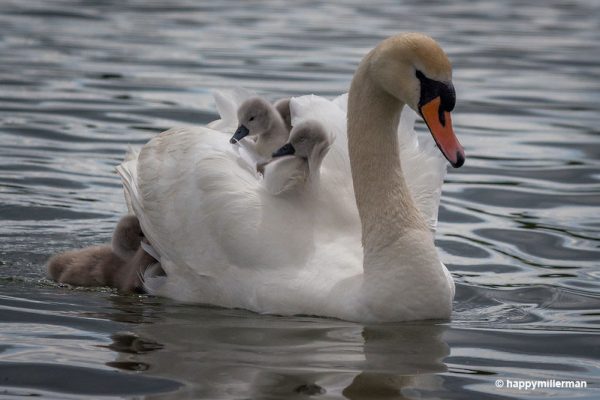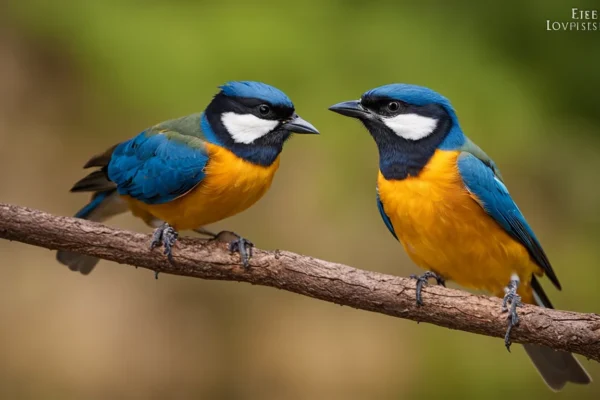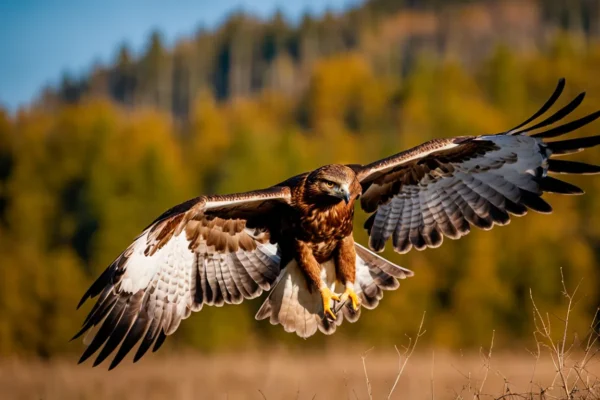When you go outdoors on a spring morning, you may see something unusual: birds chattering loudly, swooping about wildly, and chasing each other around in midair. Although the phenomena of hyperactive birds may seem strange, it is based on natural instinct and research.
We’ll explore the surprising causes of birds going crazy in your garden in this in-depth tutorial.
For those who are pressed for time, the main takeaway is that birds become more competitive in the spring as they try to pass on their genes via loud displays of territorial defense and mating attraction.
Defending Territory and Chasing Away Rivals
One common reason why birds act irrationally outside—flying wildly and creating a lot of noise—is that they have a natural need to defend their territory. Due to their strong sense of territoriality, birds will do everything it takes to create and defend their breeding grounds.
Determining Nesting Sites
A primary motivation for birds’ erratic behavior is to mark out territories for their nests. They are picky about where to make their nests; they will build them in trees, bushes, or even man-made buildings like birdhouses.
When they’ve located a good location, they aggressively protect it from other birds that could attempt to invade it.
Studies have shown that birds convey their ownership of a certain nesting place using a range of displays and signals. These exhibits may include of complex aerial acrobatics, loud vocalizations, or even head-on fights between competing birds.
Birds are able to create and protect their territories via these activities, which also help to ensure the success and safety of their progeny.
Keeping Outsiders Out
The necessity for birds to repel intruders is another factor contributing to their disarray. In an effort to get food or possible mates, other birds—both of the same species and other species—may try to encroach on a bird’s territory.
This may cause birds to aggressively protect their area from these unwelcome invaders, which can result in heated arguments and violent behavior.
According to studies, birds often use vocalizations, dive-bombing techniques, and fast chases to scare off intruders from their territory. In addition to safeguarding the bird’s resources, these aggressive outbursts serve as a warning to prospective competitors, indicating that the area is already inhabited and well-defended.
Severe Arguments About Resources
A bird needs resources like food, water, and partners to survive and reproduce successfully. Because of this, there may be fierce rivalry among the birds for these supplies, which may result in chaotic interactions.
Birds may act aggressively to get access to these essential items when resources are few.
It has been observed that birds may fight ferociously over food supplies, each using a different strategy to outbid the other. These strategies may include robbing other birds of their food, driving rivals away, or fighting each other.
The birds’ eagerness to claim their portion of the available resources results in the mayhem that arises during these confrontations.
Getting to Know Possible Partners
Birds chasing after possible mates is one of the primary causes of their irrational behavior outdoors. They need to attract a partner in order to effectively reproduce, therefore this is an important stage in their reproductive cycle.
Birds use a range of tactics, including as elaborate and loud songs, dramatic aerial displays, and nuptial displays, to attract the interest of potential mates.
Glamorous Wedding Displays
To entice partners, several bird species put on lavish, dramatic wedding displays. These exhibits may consist of elaborate dances, colorful feather displays, and exaggerated motions. Male birds will frequently go to considerable pains to demonstrate to females their physical characteristics and general fitness.
Male competitors use these displays to compete with one another in an effort to win over a female’s favor, in addition to serving as a method of attracting mates.
Bird Songs That Are Loud And Complex
Birds use their songs as an additional means of courtship. Male birds are distinguished by their complex and melodic vocalizations, which are audible across long distances. Males use these songs to signal to females their presence, territory, and general fitness.
A male bird’s capacity to produce children and maintain good health may be inferred from the intricacy and quality of his song. Male birds with the best vocalization skills tend to attract females.
Stunning Aerial Manoeuvres
Some bird species use spectacular flying feats to elevate their courtship rituals to the skies. These acrobatic performances may include coordinated motions, complicated flying patterns, and fast dives.
In an attempt to impress and win over females, male birds perform spectacular aerial displays to demonstrate their power, agility, and endurance. In addition to showcasing a male bird’s physical prowess, these amazing displays help him establish dominance and protect their territory from other males.
Gaining knowledge about the causes of outdoor bird mania will help us better understand these intriguing behaviors. We can appreciate the amazing ways these birds woo prospective mates by seeing their dramatic nuptial displays, hearing their intricate songs, and seeing their impressive flying skills.
Thus, keep in mind that birds are only attempting, in their own special manner, to find love the next time you see them going crazy outdoors!
The Science of Energetic Birds
Have you ever wondered why birds appear to have an endless supply of energy while they are outdoors, tweeting and fluttering? It turns out that this pandemonium among the birds has a scientific cause. Let’s investigate the intriguing realm of birds and discover the significance of their gregarious behavior.
Testosterone and Other Hormones
The hormones present, especially testosterone, are one of the main causes of birds’ animated behavior. Similar to humans, testosterone is essential for controlling behavior and promoting avian reproduction.
Male birds’ testosterone levels rise dramatically during mating season, which causes them to become more territorial, vocalize, and engage in wooing displays. The gregarious and exuberant behavior we often see in birds during this period is caused by this hormone surge.
Optimizing the Outcome of Reproduction
Birds’ natural desire to optimize their chances of successful reproduction is another factor contributing to their gregarious nature. Birds use a variety of behaviors to draw in mates and protect their areas. They are indicating to prospective partners that they are physically fit and appealing by singing loudly and enthusiastically.
Their gregarious demeanor also aids in the establishment and upkeep of their territories, guaranteeing them access to plenty of food supplies and appropriate nesting locations. Their ability to reproduce and ensure the survival of their progeny depend on this behavior.
Carrying On Robust Genes
Moreover, birds use their gregarious nature to pass on powerful genes to the next generation. Male birds engage in complex courting rituals to demonstrate their genetic superiority and physical prowess in an effort to attract a partner.
They are promoting their genetic fitness to prospective mates by showcasing their power, agility, and vitality. Because it improves the likelihood that their progeny will acquire these favorable genes, female birds are thus more inclined to choose a partner who has these desirable features.
Birds use their energetic behavior as a means of ensuring the continuation and success of their genetic lineage.
Additional Elements That Lead To Unruliness
There are a few more things that add to the rowdiness of birds, even if there are many explanations for their wild behavior while they are outdoors. A few of these variables include deteriorating habitats, abnormally high temperatures, and irregular migratory patterns.
Reduction in Natural Environments
Appropriate environments are necessary for birds to survive and perform their daily tasks. Regrettably, the pace at which their natural habitats are disappearing is frightening because of urbanization and deforestation. Because of this, birds often have to adjust to new surroundings, which may result in elevated stress levels and changes in behavior.
Birds get more anxious and frantic when there are less trees, plants, and other natural resources available to them for food.
Unusually High Temperatures
Many parts of the globe have seen rising temperatures as a result of climate change. The normal rhythms of eating and breeding for birds may be disturbed by this temperature increase. Their energy levels and metabolism may also be impacted, leading to strange behavior.
Furthermore, prolonged heat waves may cause dehydration and a shortage of water supplies, which makes birds even more stressed and angrier.
Disturbance in Migration Trends
For many bird species, migration is a necessary trait that enables them to locate appropriate nesting sites and food supplies all year long. But elements like pollution, deforestation, and altered weather patterns may interfere with their migratory paths.
Increased bustle and turmoil might result from birds being lost and confused when they are unable to follow their typical migratory route. As a consequence of this disturbance, birds may become more raucous in certain regions due to congestion as they search for other habitats.
Knowing these possible causes helps clarify why the birds outside could be acting strangely. Keep in mind that birds are very sensitive animals, and that any disruption to their natural habitat may have a big influence on how they behave.
Birds and people may live in greater harmony if we solve these environmental problems and support conservation initiatives.
Taking in the Avian Display
It’s difficult not to be enthralled with the avian display when birds go bonkers outdoors, filling the air with their beautiful melodies and brilliant colors. We are often left wondering about the significance of their apparently disorganized conduct by this event.
But rather of writing it off as just noise and disturbance, taking the effort to recognize and comprehend this occurrence may provide insightful knowledge about the natural world.
An Indicia Of A Stable Ecosystem
A thriving environment might be the cause of the avian turmoil, according to one theory. For food, housing, and nesting sites, birds depend on their surroundings. An availability of resources and a robust ecology are indicated when large numbers of birds congregate and engage in active activities.
This is excellent news for those who love the outdoors since it shows that a wide variety of bird species can coexist in the region.
Millions of people worldwide enjoy the pastime of birdwatching, according to the National Audubon Society. It offers a means of connecting with nature and appreciating the beauty of the avian world in addition to being a source of amusement and relaxation.
Observing birds in their natural habitats and learning about their intricate behavior may be gratifying experiences that come with birdwatching.
Evolution At Work
When birds go nuts outdoors, it’s also important to keep in mind that this might be an example of evolution at action. Birds have evolved a variety of survival and environmental adaptation techniques throughout time.
Certain birds, like starlings, move in captivating murmurations where thousands of them follow coordinated rhythms. In addition to avoiding predators, this activity facilitates communication and mating selection.
Scientists at Cornell University have done research that has illuminated the underlying mechanics of these bird displays. They have discovered that the complex flying patterns and social interactions of starlings are the outcome of group decision-making and information exchange within the flock.
Knowing these evolutionary adaptations helps us appreciate birds even more and provides important insights into how basic interactions may develop into complex behaviors.
Getting In Touch With Nature
Finally, we have a chance to develop a closer relationship with nature because of the avian turmoil outside our windows. It may be really good for our wellbeing to take a minute in our fast-paced, technologically-driven society to notice and appreciate the natural world around us.
Spending time in nature has been shown to lower stress, elevate mood, and improve mental health in general.
Thus, the next time you hear the birds soaring outdoors, stop for a minute and enjoy the natural sight of birds. These instances may be really breathtaking, whether they serve as a signal of a robust ecosystem, an example of evolution in action, or a call to go closer to the natural world.
Let’s embrace the mayhem and take delight in the wonder and beauty of our feathery companions.
Final Thoughts
Even while noisy birds might be an annoyance, their exuberant behavior during the spring is motivated by instincts to establish the finest territories, attract possible mates, and spread the species. It is possible for us to appreciate the marvels of nature when we comprehend the science behind their behavior.
The next time you see birds flying in your yard, stop and enjoy the vibrant display!






